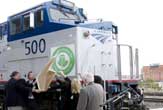
Amtrak has begun a year-long trial of a beef-based biodiesel fuel to power its Heartland Flyer passenger train that runs between Oklahoma City and Ft. Worth, Texas. The goal is to reduce carbon dioxide emissions and dependence on foreign oil.
The fuel, which is a blend of regular diesel and 20 percent beef byproducts — made from rendered fat — is expected to reduce hydrocarbons and carbon monoxide emissions by 10 percent, particulates by 15 percent and sulfates by 20 percent, based on the results of initial stationary tests.
Because the biodiesel fuel burns faster than straight diesel, the train’s 3,200-horsepower G.E. P32-8 locomotive will gulp more fuel during its daily 412-mile round trip. The Heartland Flyer has been making that run since 1999, with stops along the way at Norman, Purcell, Pauls Valley and Ardmore in Oklahoma and Gainesville in Texas. The train uses about 100,000 gallons a fuel a year.
Little modification
The use of biodiesel requires little or no engine modification. At the end of the test, detailed measurements will be taken to see if the fuel had an effect on the engine’s valves and gaskets.
The anticipated environmental savings also carry a higher price tag at the pump. The biodiesel Amtrak is using costs from 5- to 10-cents more per gallon than conventional diesel, Amtrak Chicago-based spokesman Marc Magliari told TechNewsDaily. "The price spread has narrowed over the past three or four years."
Amtrak didn’t deliberately set out to source a fuel with beef as an ingredient. Like a foodie selecting locally grown groceries, the railroad picked the beef blend, which comes from a vendor in Texas, because it was the most readily available in that part of the country. "It just happens to be the available fuel in that market," said Magliari. "We are thinking globally and buying locally."
Get the world’s most fascinating discoveries delivered straight to your inbox.
The biodiesel test is being funded by a $274,000 grant from the Federal Railroad Administration.
Being "greener" is one of six strategic goals for Amtrak. The biodiesel test on the Heartland Flyer is just one element of the environmental management programs and practices the passenger railroad company is implementing to create a more sustainable transportation system. "We’ve been sensitive to our stewardship of the planet for a long, long time," Magliari said.
Stink Free
Other efforts include reducing the amount of idling time on diesel locomotives, using dynamic and regenerative braking systems of electric locomotives to return energy to the grid, employing bio-lubricants in hydraulic systems and using lighter and more aerodynamic vehicle carriers for the Auto Train that ferries passengers and their personal vehicles between Florida and the Washington, D.C. suburbs.
The Heartland Flyer will be as friendly to your nose as it is the environment, Magliari said. The train won’t roar along its route trailing a cloud of fumes smelling like hamburgers. There’s no hint of its beef provenance. "It’s not like the vegetable oil from French fries in cars," he said, referring to complaints from owners of cars that run on fryer grease from fast-food restaurants.
Appropriately, Amtrak launched the service in late April, during Earth Week.


